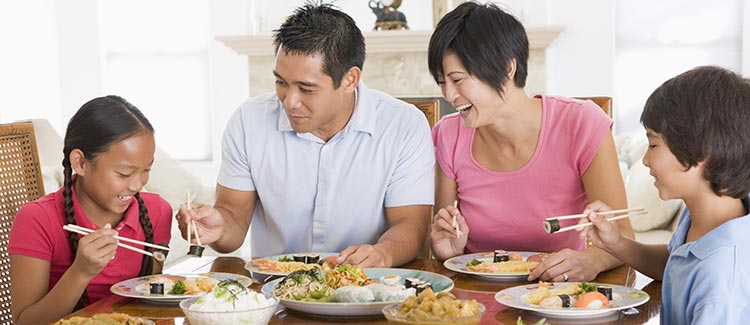Research has shown that discussions at the dinner table can help develop children’s language skills. We asked GreatSchools staff to share their tried and true conversation starters — what works with their families today and what worked when they were kids. Here’s what they had to say:
Jennifer
Have each child select a word of the day for the next day in the dictionary. Each child learns his or her word, uses it in a sentence, and then gets to use it the next day as many times as possible. The stories can be told the next night.
Play 20 questions with a theme each night. These could be topics such as ancient cities, state capitols, mammals, etc. This is a great way to keep the whole table engaged and forces kids to research prior to mealtime.
“What did you learn today?” This one is a classic and is fun for little kids — it encourages them to be aware of the learning process.
Lisa F.
Family dinners are not the ideal American family dinner at the Fung-Aguirre household. I rush out of work, pick up kids around the city, and come home. When there’s no parent-teacher potluck, school committee meeting, or karate tournament in the evening, we eat dinner together. We take frozen food out of the freezer, and , with everyone’s allergies and picky palates, I end up making three to four dinners. I feed the kids first and then myself and, on a lucky evening, Robert. We crowd around the kitchen table and quickly chat about all the things that need to be done before bed — practice guitar, two pages of Kumon, homework, brush teeth, shower, change into pajamas, and read. I’m basically preparing the troops for the race to their beds.
On the other hand, Sunday brunches are when I can make pancakes (yes, I know …it’s just mix and water, but I call it “make”), cut the fruit, scramble some eggs, and we can all have a leisurely breakfast conversation about the week, weekend, what we liked, who’s our friend of the week and who’s not, and what too look forward to next week. It’s a time of reflection, catching up, and looking forward.
Chase
Your sports teams: Being from a big sports family, discussing the 49ers or Giants always got the kids (my brother and me) involved in the dialogue and still does to this day at family dinners.
Nutrition: Also, having a mother nicknamed “Mrs. Vegetable” by all my friends, the taste-versus-nutritional-value debate was constant at our kitchen table. This could certainly become a heated debate depending on someone’s aversion to the Brussels sprouts on their plate.
Highs and lows: Easy and effective. Going around the table and sharing your highs and lows for the day get’s everyone involved and talking. Even the teenage brother who would rather grunt out two lows than offer a high. This is something that my family did often.
Otherwise, dinners in my family were often about listening to my dad and mom explain what they did that day, which, at an elementary school age, certainly got us asking those incessant “why” questions.
Jamie
Have each person tell a joke, or one person per night tell a joke and trade off joke-telling days.
Have theme nights once a week and let children be involved in picking the theme, examples are Taco Night, Pasta Night, Salad Night, etc. Then have children give their feedback or talk about what they like best about the theme.
Ask fun questions at the table and let each person tell you what and why they pick what they do: “If you were any animal, what would you be and why?”
Stay positive at the dinner table; don’t use dinner table conversation as a time to criticize or reprimand children.
Lisa R.
One of the best conversation starters I’ve found is to ask two simple questions that everyone at the table gets the chance to answer: “What was the best thing that happened to you today? What was the worst?”
Sera
The general approach my parents took to improving my siblings’ and my vocabulary and conversation skills was — from a very, very young age — to always treat us and speak to us as if we were adults. For instance, my parents generally had lively conversations all the time about local, national, and international politics. If we children were in the room, we were expected to fully participate and describe and debate our views (yes, I’m sure this meant years of “What do you think of Reagan’s stance on the world economy?” “He’s a butthead.” “Why do you think he’s a butthead and is there any term you could use instead of ‘butthead’ that would better convey what you actually mean?”, etc.). This helped make us kids better informed, understand the value of this type of conversation, learn new vocabulary through current events, and also learn how to thoughtfully develop and articulate one’s political, religious, and social views.
Kristin
Dinner guests! Whether we had one of our young friends or an adult (family friend or professional colleague)over to dinner, the conversation was always interesting. We loved hearing new stories, and consequently we learned to listen and ask good questions.
I grew up in a household where we often ate dinner in three shifts: My little sister and I ate at 5:00, our teenage siblings ate later (after their sports and music activities), and my physician father ate with my mother at 11:00 p.m. What made it all work was that my mother always sat and talked with us while we ate our dinner. She would knit or crochet but was really tuned into us. She ignored the phone, the TV stayed off, etc. Mom taught us about cooking a balanced meal by aiming for a variety of colors on the plate. This is common advice today but was a novel concept in the 1970s. Sometimes she’d tell us the history of a particular family recipe, which triggered questions about relatives, family traditions, etc.
Dave
My family always placed politics front-and-center at the dinner table. My dad would pretend he was a John McLaughlin-like TV host and we’d have spirited debates with each family member taking opposing sides. It made for exciting dinners. It also encouraged me to read the newspaper each day so that I could meaningfully participate in the discussion (and, on occasion, win an argument or two).
Marisa P.
We generally start the conversation by engaging the most creative and outspoken person in the room since this person is sure to bring up a topic of interest. One example — that special family vacation we took and how fun it was — we then have someone share their special moment.
I visited the largest empty volcano in the world on a recent trip. I told all about it, including the types of rocks and species found there. It was great to revisit our family vacation and get everyone in the room involved.






